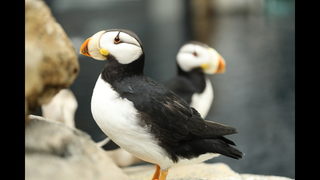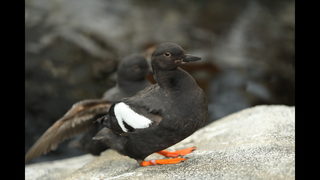Coming soon to Georgia Aquarium: seabirds. This new exhibit will feature four different species of seabirds from the North Pacific, including: horned puffins, tufted puffins, common murres, and pigeon guillemots. The new habitat will open in the Aquarium’s Cold Water Quest gallery across from fellow cold-water inhabitants, the Southern sea otters.
New animals will soon land at the @GeorgiaAquarium! Check out the Puffins!
— Nelson Hicks (@NelsonHicksWSB) December 13, 2017
More https://t.co/tBRJYWOdwY pic.twitter.com/2DCKBCvFng
The puffin exhibit will open at Georgia Aquarium on Friday, January 19, 2018! Through a partnership with the Alaska SeaLife Center (ASLC), Georgia Aquarium was able to bring some of these birds to Atlanta over the last few months. ASLC has been caring for additional birds, which are now making their way to Atlanta ahead of the exhibit’s opening.

The exhibit will contain more than 11,000 gallons of water and intricate rockwork and other features closely resembling these birds’ native cliff-side dwellings. Ornate rockwork will also spill to the outside of the exhibit which will boast tall acrylic windows, giving guests above water and underwater views.

Georgia Aquarium is also working with other aquarium partners as well as the Association of Zoos and Aquariums’ (AZA) Species Survival Plan (SSP) for these seabirds. The SSP oversees the sustainable population management of select species at AZA institutions and works to enhance the conservation of these species.

Puffins, murres, and guillemots are all members of the alcid family. Alcids are pelagic seabirds and are uniquely adapted to marine environments. Puffins have small wings and legs set back on their bodies, making them excellent swimmers and divers. But, this also makes them very clumsy on land and taking flight can be a challenge for these popular birds. Horned puffins have a large orange-to-red beak while tufted puffins have a large orange beak with white coloration around the sides of their heads. Both pigeon guillemots and common murres are dark brownish-black birds with red legs.

Alcids are often confused for but not related to penguins. Alcids are found in the Northern Hemisphere and have the ability to fly, albeit, with some work. These birds have short wingspans and must run, jump, or beat their wings rapidly to produce enough momentum to take flight. Penguins, however, are unable to fly and are found in the Southern Hemisphere.
While these seabirds are listed as “Least Concern” on the International Union for the Conservation of Nature Red List, they still face dangers. Puffins are frequently caught in fishing bycatch and many are found to carry toxins – mercury and cadmium - most likely from the fish they eat. Common murres faced a historic die-off in 2015 and 2016. Researchers believe their food source ventured farther into the ocean with warming temperatures, leading to starvation.
This newest addition is included with General Admission and Memberships.
Cox Media Group





